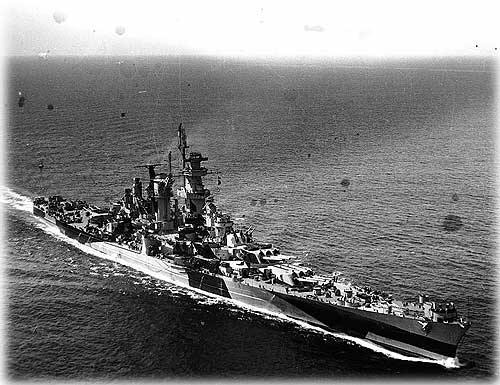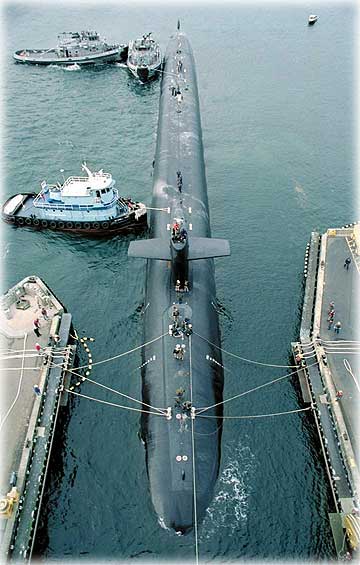 By DAVE KIFFER August 04, 2008
Technically, the USS Alaska was large or heavy cruiser, it's firepower being more than 50 percent more than that of the traditional Baltimore class American cruisers. At more than 800 feet in length, the Alaska was longer than several of the World War II era battleships of the South Dakota class, but it some 17 feet narrower and weighed just under 30,000 tons, much less than the battleships.  Photographed underway on 11 September 1944. Official U.S. Navy Photograph, from the collections of the Naval Historical Center.
The USS Alaska's keel was laid down on December 17, 1941, only 10 days after the attack on Pearl Harbor. She was built by New York Shipbuilding Corporation in Camden New Jersey. Her official launch date was August 15, 1943 and her launch was presided over by the wife of Alaska Territorial Gov. Ernest Gruening. The USS Alaska was commissioned into the navy on June 17th, 1944 with Captain Peter Fischler in command. The ship and its 2,200 member crew then spent the next six months in training missions in the Atlantic and Caribbean before finally going through the Panama Canal in December and heading for San Francisco. Although the war in Europe was in its final stages, at the time it was expected that the war against the Japanese could last several more years, culminating with an invasion of the Japanese home islands. The reality turned out to be that the USS Alaska would arrive in the Pacific just in time for the last eight months of the war. In January, the ship arrived in Pearl Harbor and Captain Kenneth Noble replaced Fischler who was promoted to rear admiral, according to the Naval History Center. By early February, the Alaska was on station in the western Pacific. Her first duty was helping to screen for the carriers Saratoga and Enterprise as they bombed Tokyo and its airfield. Most of the crew had never seen action. Backing Up The 'Pitchers' According to the Naval History Center, Captain Noble sought to reassure the crew, using familiar terminology. "We are a member of a large task force which is going to pitch directly over the home plate of the enemy," he spoke over the ship's public address system, according to History Center records. "It is our particular job to back up the pitchers." It was to be the first major carrier strike against the Japanee home islands and its approach went undetected because of bad weather in the area. All of the crew's anti-aircraft training went for naught as there was no Japanese response to the 19-hour long carrier strike, according to the History Center. In March, the carrier task force made another strike - this time against airfields on Kyushu, Shikiku and western Honshu islands. And this time there was a response from the Japanese. The Alaska's first official "action" of World War II, was around 8 am on the morning of March 18 when its guns engaged a Japanese Yokusua PIY suicide attack on the carrier Intrepid. The plane exploded a half mile from the carrier, after a direct hit from the Alaska, according to the Naval History Center. Unfortunately, the ship's next confirmed "kill" - about 15 minutes later was friendly - a Navy Hellcat - that approached the cruiser during the heat of battle. Fortunately, the pilot was uninjured and was rescued from the water. Later in the day, the Alaska was credited with shooting down another Japanese suicide plane. The following day, March 19, the carrier group engaged a large Japanese surface fleet just over the horizon. But this time, the Japanese were also on the attack and the enemy planes reached the carrier fleet shortly after the US planes had left. Both the carriers Franklin and Wasp were hit by enemy bombs. The American carrier task force chose to withdraw and the Alaska and the Guam were part of a smaller group tasked with protecting the Franklin during the retreat. Several small skirmishes took place with Japanese aircraft but the four day "cover" mission was successful and the Franklin made it safely to Guam. The USS Alaska's next mission was support for the carrier strikes prior to the invasion of Okinawa on April 1, 1945. It took a slight detour on March 27th when it was ordered to bombard the shore of Minami Daito Shimo a small island east of Okinawa. There was no return fire and the crew noted "satisfactory" fires in the island's radar installations after the bombardment, according to the History Center. Action At Okinawa Operating off Okinawa during the April invasion, the Alaska "splashed" at least three enemy planes, according to Naval records.
Although the nearly two month long battle for Okinawa was one of the bloodiest of the war - nearly 2,000 kamikazi raids sunk several dozen smaller US vessels and killed more than 5,000 sailors - the USS Alaska made it through the battle unscathed, according to Naval records. By mid May, the Alaska and her crew were off the front lines for some needed R and R, but in early June they were back in escort duty as several smaller islands near Okinawa were shelled or invaded. Then the USS Alaska was posted to patrol in the East China Sea area for most of June and July while preparations went ahead for the invasion of Japan. But the dropping of the atom bombs on Hiroshima and Nagasaki changed everthing. Most people believe the bomb drops on Aug. 6 and 9 ended the war, but it was actually a week later that the Japanese surrendered. In the meantime, the Alaska was involved in one of the last skirmishes of the war. Anchored next to the battleship Pennsylvania in Buckner Bay on Okinawa on Aug. 12, the crew of the Alaska was jarred awake by an explosion on the Pennsylvania which had been hit by a single Japanese torpedo bomber which had evaded detection. The Alaska's crew responded to the sinking battleship and helped rescue crew members and prevent the ship from settling to the bottom of the bay. It was a reminder that the war was still on. After the official end of the war, the Alaska became part of the 7th Fleet's "occupation" forces and help secure several areas in the Yellow Sea and the Korean peninsula - most notably a landing of US forces as Inchon in Korea. She remained on station in Korea and China until mid November then set sail for the US, arriving on the East Coast in mid December. In February, she was berthed in Bayonne, New Jersey, a year later she was taken out of commission and placed in reserve. Although there was some discussion about restoring the ship to active duty during the Korean War 1950-1953, it didn't happen. The name USS Alaska was struck from the Naval Register on June 1, 1960 and 29 days later the ship was sold to the Lipsett Division of Luria Brothers of New Yorn and broken up for scrap. A Fourth USS Alaska For nearly 20 years, the USS Alaska name was dormant. Then in 1978, a time when nuclear submarines were being named after states, a fourth USS Alaska was born. The contract to build the Ohio-class ballistic missile submarine USS Alaska was awarded to the Electric Boat division of General Dynamics in Groton, Connecticut on Feb. 27, 1978. The keel was laid on March 9, 1983. The official launching was Jan. 12, 1985, with Sen. Ted Stevens' wife, Catherine, doing the honors. The submarine was commission on Jan. 25, 1986 with two rotating crews. Capt. Paul Callahan was in command of the blue crew and Cap. Charles Chotvacs in command of the gold crew. In September of 1986, the ship made is first transit through the Panama Canal on its way to Bangor Washington. On board were nearly 100 Alaskan dignitaries, including then Gov. Bill Sheffield. For nearly 20 years, the ship was stationed in Bangor, but in 2006 its homeport was changed to Kings Bay, Georgia. At least one public tour of the ship was held in Ketchikan in the early 1990s when the submarine visited the Back Island naval facility. The ship was docked at the Ketchikan Coast Guard based and residents scrambled down the narrow passageways on the 500 foot ship and met with many members of the 150 person crew. Of most interest were the crew sleeping quarters which were wrapped around the 24 Trident nuclear missile tubes at mid ship. At the time, the crew members didn't think it odd to be sleeping next to nuclear missiles. "They have to put them somewhere," said one sailor with a smile.
Editor's Note:
On the Web:
Dave Kiffer is a freelance writer living in Ketchikan, Alaska. To republish this article, the author requires a publication fee. Contact Dave at dave@sitnews.us
|
|||
